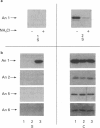Abstract
1. We have studied the ability of the glucocorticoid, dexamethasone, to induce annexin 1 secretion by either human blood monocytes or rat peritoneal leukocytes. 2. The in vivo treatment of rats with dexamethasone (1.25 mg kg-1) selectively induced secretion of annexin 1 by peritoneal leukocytes, as assessed by incubating these cells in culture medium. Annexin 1 secretion was also induced in human cultured monocytes, in vitro, by 10(-6) M dexamethasone. 3. Annexin 1 secretion was inhibited in the presence of 20 mM NH4Cl or by conducting the experiments at 18 degrees C. In contrast, it was not inhibited by monensin, nocodazole or brefeldin A. 4. The time necessary for annexin 1 synthesis and secretion was less than 15 min. 5. These data indicate that glucocorticoids induce annexin 1 secretion by monocytes or peritoneal leukocytes. Because it is not inhibited by monensin, nocodazole or brefeldin A and it is rapid, annexin 1 secretion seems to occur by the secretory pathway similar to that used by several cytosolic proteins such as interleukin-1 beta.
Full text
PDF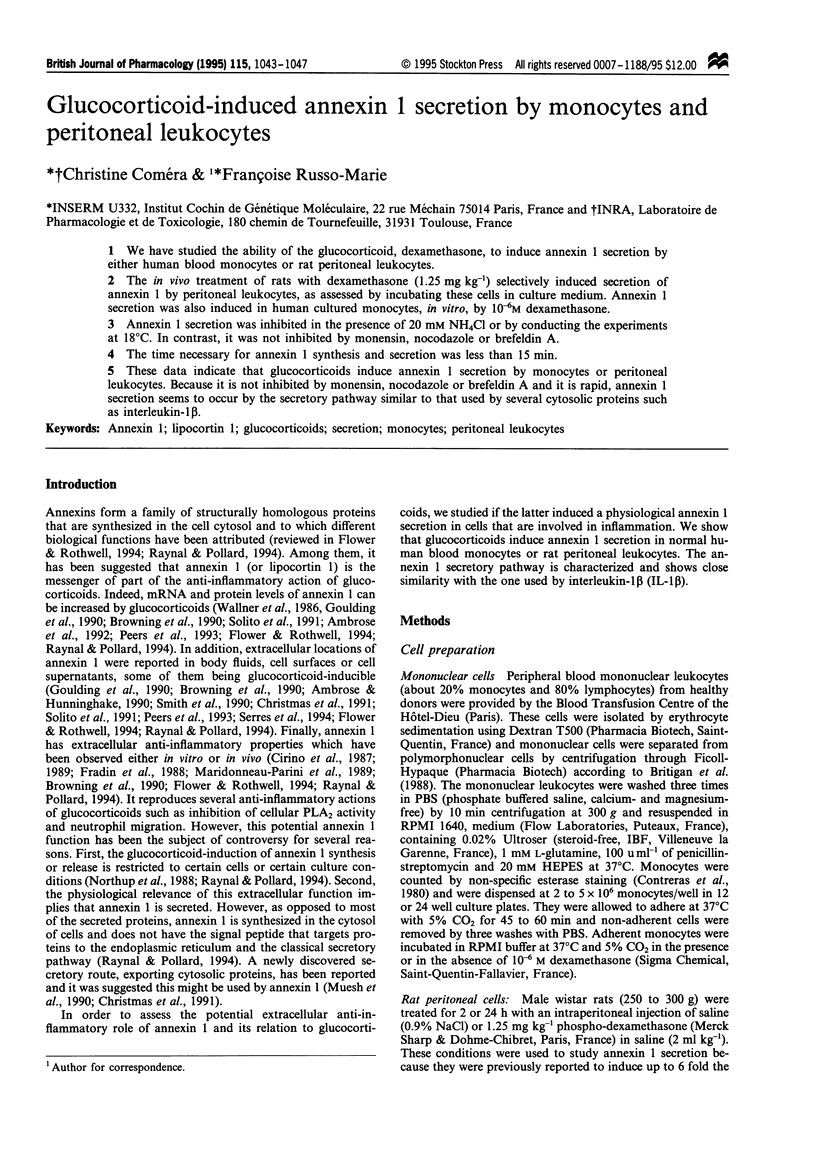

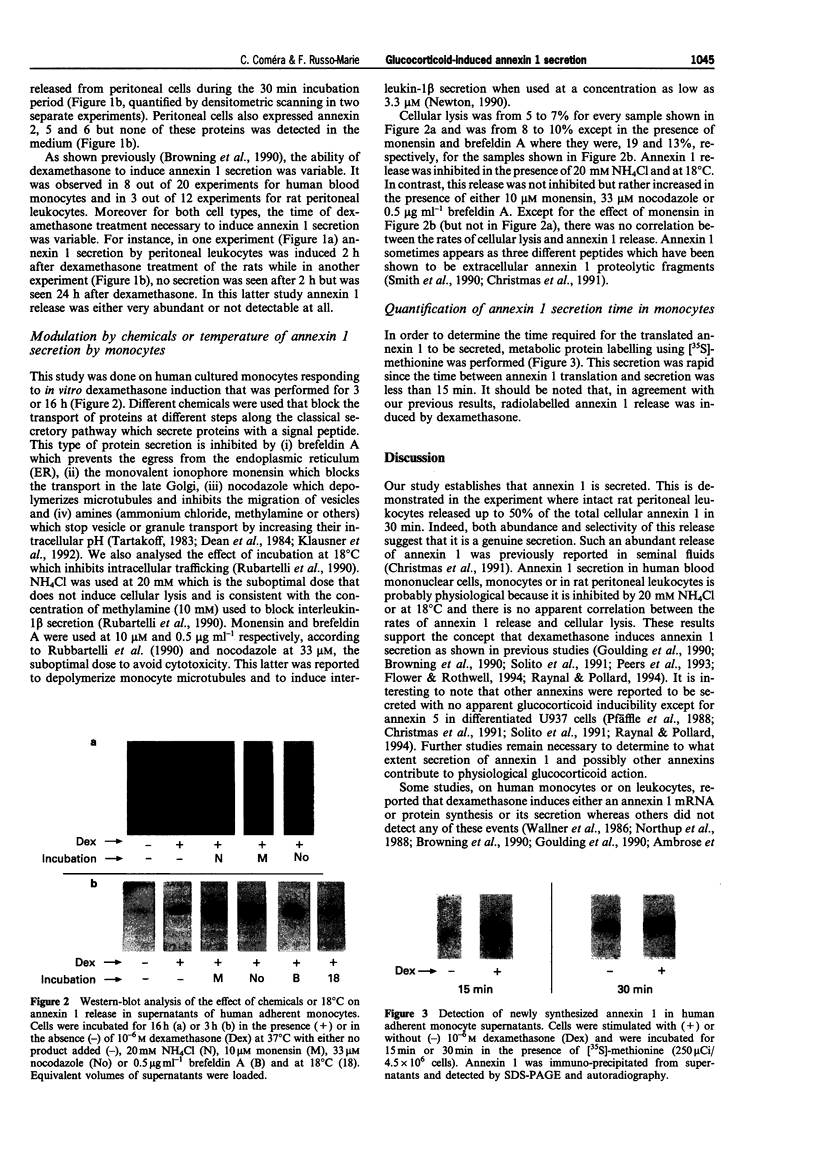
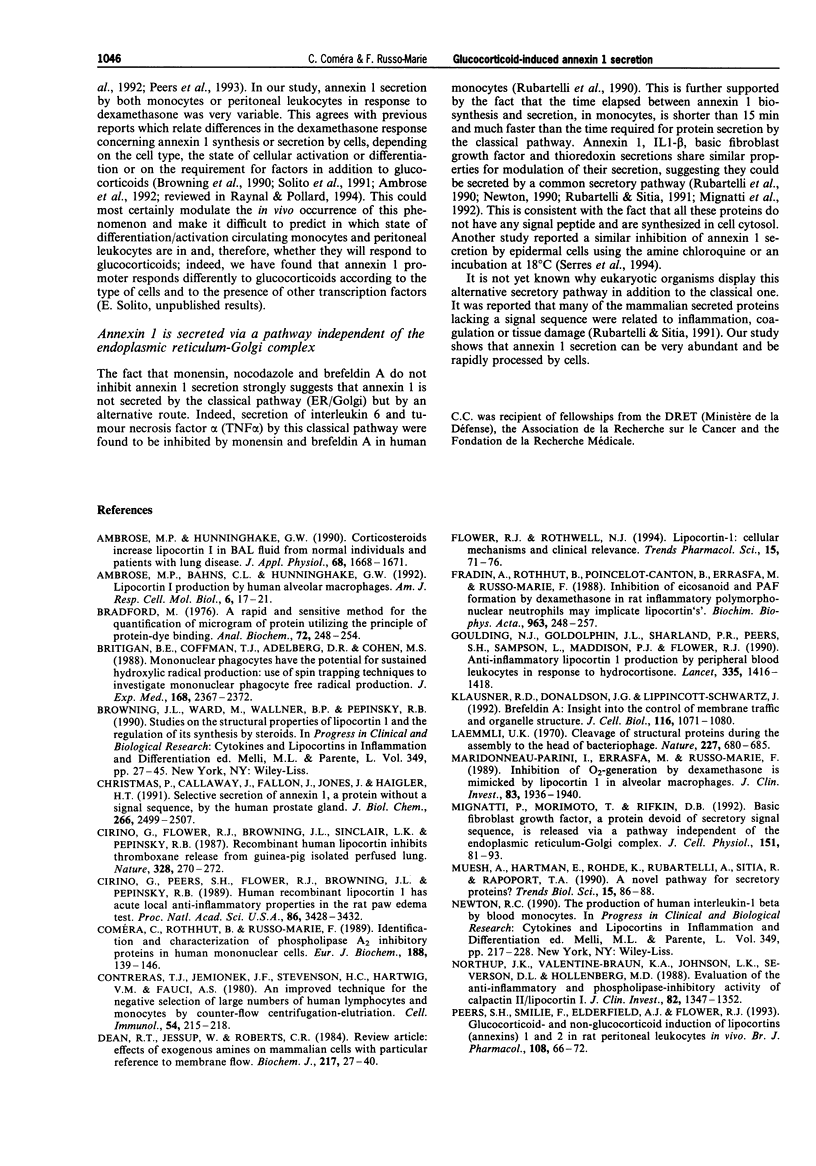
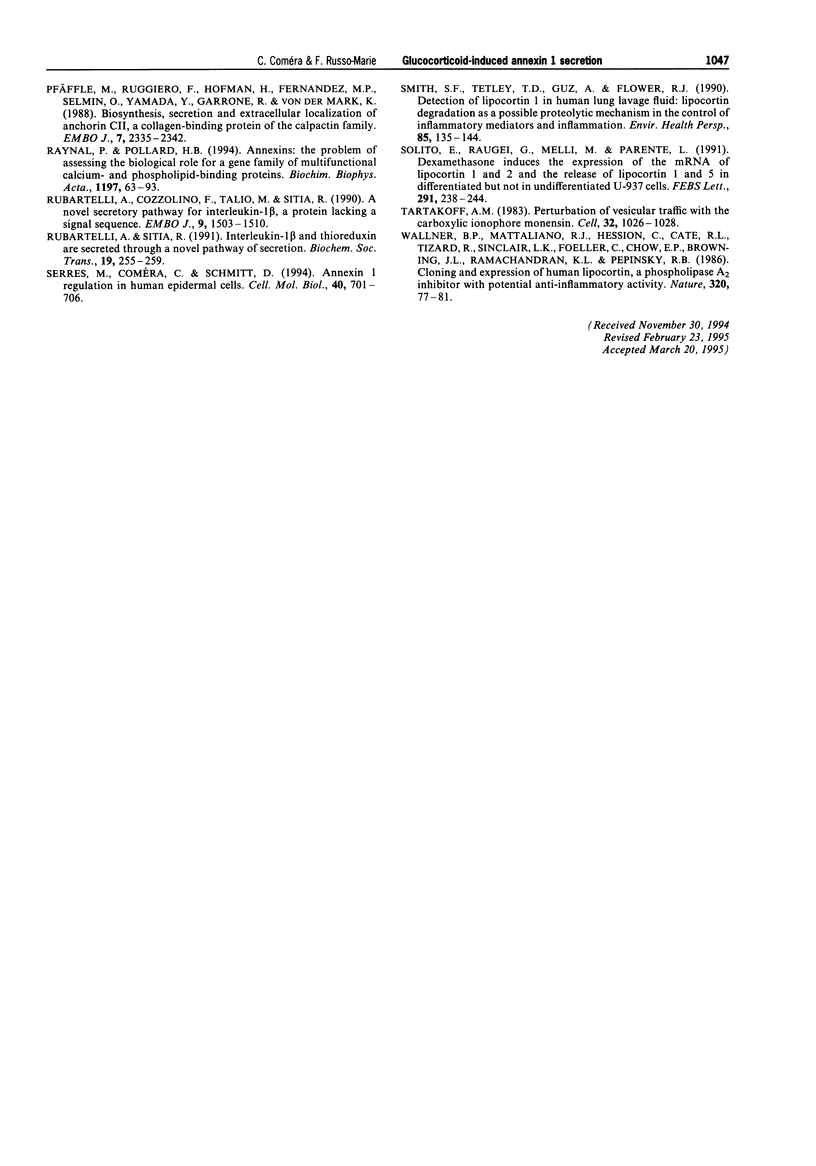
Images in this article
Selected References
These references are in PubMed. This may not be the complete list of references from this article.
- Ambrose M. P., Bahns C. L., Hunninghake G. W. Lipocortin I production by human alveolar macrophages. Am J Respir Cell Mol Biol. 1992 Jan;6(1):17–21. doi: 10.1165/ajrcmb/6.1.17. [DOI] [PubMed] [Google Scholar]
- Ambrose M. P., Hunninghake G. W. Corticosteroids increase lipocortin I in BAL fluid from normal individuals and patients with lung disease. J Appl Physiol (1985) 1990 Apr;68(4):1668–1671. doi: 10.1152/jappl.1990.68.4.1668. [DOI] [PubMed] [Google Scholar]
- Bradford M. M. A rapid and sensitive method for the quantitation of microgram quantities of protein utilizing the principle of protein-dye binding. Anal Biochem. 1976 May 7;72:248–254. doi: 10.1016/0003-2697(76)90527-3. [DOI] [PubMed] [Google Scholar]
- Britigan B. E., Coffman T. J., Adelberg D. R., Cohen M. S. Mononuclear phagocytes have the potential for sustained hydroxyl radical production. Use of spin-trapping techniques to investigate mononuclear phagocyte free radical production. J Exp Med. 1988 Dec 1;168(6):2367–2372. doi: 10.1084/jem.168.6.2367. [DOI] [PMC free article] [PubMed] [Google Scholar]
- Christmas P., Callaway J., Fallon J., Jones J., Haigler H. T. Selective secretion of annexin 1, a protein without a signal sequence, by the human prostate gland. J Biol Chem. 1991 Feb 5;266(4):2499–2507. [PubMed] [Google Scholar]
- Cirino G., Flower R. J., Browning J. L., Sinclair L. K., Pepinsky R. B. Recombinant human lipocortin 1 inhibits thromboxane release from guinea-pig isolated perfused lung. Nature. 1987 Jul 16;328(6127):270–272. doi: 10.1038/328270a0. [DOI] [PubMed] [Google Scholar]
- Cirino G., Peers S. H., Flower R. J., Browning J. L., Pepinsky R. B. Human recombinant lipocortin 1 has acute local anti-inflammatory properties in the rat paw edema test. Proc Natl Acad Sci U S A. 1989 May;86(9):3428–3432. doi: 10.1073/pnas.86.9.3428. [DOI] [PMC free article] [PubMed] [Google Scholar]
- Coméra C., Rothhut B., Russo-Marie F. Identification and characterization of phospholipase A2 inhibitory proteins in human mononuclear cells. Eur J Biochem. 1990 Feb 22;188(1):139–146. doi: 10.1111/j.1432-1033.1990.tb15381.x. [DOI] [PubMed] [Google Scholar]
- Contreras T. J., Jemionek J. F., Stevenson H. C., Hartwig V. M., Fauci A. S. An improved technique for the negative selection of large numbers of human lymphocytes and monocytes by counterflow centrifugation--elutriation. Cell Immunol. 1980 Aug 15;54(1):215–229. doi: 10.1016/0008-8749(80)90203-8. [DOI] [PubMed] [Google Scholar]
- Dean R. T., Jessup W., Roberts C. R. Effects of exogenous amines on mammalian cells, with particular reference to membrane flow. Biochem J. 1984 Jan 1;217(1):27–40. doi: 10.1042/bj2170027. [DOI] [PMC free article] [PubMed] [Google Scholar]
- Flower R. J., Rothwell N. J. Lipocortin-1: cellular mechanisms and clinical relevance. Trends Pharmacol Sci. 1994 Mar;15(3):71–76. doi: 10.1016/0165-6147(94)90281-x. [DOI] [PubMed] [Google Scholar]
- Fradin A., Rothhut B., Poincelot-Canton B., Errasfa M., Russo-Marie F. Inhibition of eicosanoid and PAF formation by dexamethasone in rat inflammatory polymorphonuclear neutrophils may implicate lipocortin 's'. Biochim Biophys Acta. 1988 Nov 25;963(2):248–257. doi: 10.1016/0005-2760(88)90288-3. [DOI] [PubMed] [Google Scholar]
- Goulding N. J., Godolphin J. L., Sharland P. R., Peers S. H., Sampson M., Maddison P. J., Flower R. J. Anti-inflammatory lipocortin 1 production by peripheral blood leucocytes in response to hydrocortisone. Lancet. 1990 Jun 16;335(8703):1416–1418. doi: 10.1016/0140-6736(90)91445-g. [DOI] [PubMed] [Google Scholar]
- Klausner R. D., Donaldson J. G., Lippincott-Schwartz J. Brefeldin A: insights into the control of membrane traffic and organelle structure. J Cell Biol. 1992 Mar;116(5):1071–1080. doi: 10.1083/jcb.116.5.1071. [DOI] [PMC free article] [PubMed] [Google Scholar]
- Laemmli U. K. Cleavage of structural proteins during the assembly of the head of bacteriophage T4. Nature. 1970 Aug 15;227(5259):680–685. doi: 10.1038/227680a0. [DOI] [PubMed] [Google Scholar]
- Maridonneau-Parini I., Errasfa M., Russo-Marie F. Inhibition of O2- generation by dexamethasone is mimicked by lipocortin I in alveolar macrophages. J Clin Invest. 1989 Jun;83(6):1936–1940. doi: 10.1172/JCI114101. [DOI] [PMC free article] [PubMed] [Google Scholar]
- Mignatti P., Morimoto T., Rifkin D. B. Basic fibroblast growth factor, a protein devoid of secretory signal sequence, is released by cells via a pathway independent of the endoplasmic reticulum-Golgi complex. J Cell Physiol. 1992 Apr;151(1):81–93. doi: 10.1002/jcp.1041510113. [DOI] [PubMed] [Google Scholar]
- Muesch A., Hartmann E., Rohde K., Rubartelli A., Sitia R., Rapoport T. A. A novel pathway for secretory proteins? Trends Biochem Sci. 1990 Mar;15(3):86–88. doi: 10.1016/0968-0004(90)90186-f. [DOI] [PubMed] [Google Scholar]
- Northup J. K., Valentine-Braun K. A., Johnson L. K., Severson D. L., Hollenberg M. D. Evaluation of the antiinflammatory and phospholipase-inhibitory activity of calpactin II/lipocortin I. J Clin Invest. 1988 Oct;82(4):1347–1352. doi: 10.1172/JCI113737. [DOI] [PMC free article] [PubMed] [Google Scholar]
- Peers S. H., Smillie F., Elderfield A. J., Flower R. J. Glucocorticoid-and non-glucocorticoid induction of lipocortins (annexins) 1 and 2 in rat peritoneal leucocytes in vivo. Br J Pharmacol. 1993 Jan;108(1):66–72. doi: 10.1111/j.1476-5381.1993.tb13441.x. [DOI] [PMC free article] [PubMed] [Google Scholar]
- Pfäffle M., Ruggiero F., Hofmann H., Fernández M. P., Selmin O., Yamada Y., Garrone R., von der Mark K. Biosynthesis, secretion and extracellular localization of anchorin CII, a collagen-binding protein of the calpactin family. EMBO J. 1988 Aug;7(8):2335–2342. doi: 10.1002/j.1460-2075.1988.tb03077.x. [DOI] [PMC free article] [PubMed] [Google Scholar]
- Raynal P., Pollard H. B. Annexins: the problem of assessing the biological role for a gene family of multifunctional calcium- and phospholipid-binding proteins. Biochim Biophys Acta. 1994 Apr 5;1197(1):63–93. doi: 10.1016/0304-4157(94)90019-1. [DOI] [PubMed] [Google Scholar]
- Rubartelli A., Cozzolino F., Talio M., Sitia R. A novel secretory pathway for interleukin-1 beta, a protein lacking a signal sequence. EMBO J. 1990 May;9(5):1503–1510. doi: 10.1002/j.1460-2075.1990.tb08268.x. [DOI] [PMC free article] [PubMed] [Google Scholar]
- Rubartelli A., Sitia R. Interleukin 1 beta and thioredoxin are secreted through a novel pathway of secretion. Biochem Soc Trans. 1991 Apr;19(2):255–259. doi: 10.1042/bst0190255. [DOI] [PubMed] [Google Scholar]
- Serres M., Comera C., Schmitt D. Annexin 1 regulation in human epidermal cells. Cell Mol Biol (Noisy-le-grand) 1994 Jul;40(5):701–706. [PubMed] [Google Scholar]
- Smith S. F., Tetley T. D., Guz A., Flower R. J. Detection of lipocortin 1 in human lung lavage fluid: lipocortin degradation as a possible proteolytic mechanism in the control of inflammatory mediators and inflammation. Environ Health Perspect. 1990 Apr;85:135–144. doi: 10.1289/ehp.85-1568329. [DOI] [PMC free article] [PubMed] [Google Scholar]
- Solito E., Raugei G., Melli M., Parente L. Dexamethasone induces the expression of the mRNA of lipocortin 1 and 2 and the release of lipocortin 1 and 5 in differentiated, but not undifferentiated U-937 cells. FEBS Lett. 1991 Oct 21;291(2):238–244. doi: 10.1016/0014-5793(91)81293-h. [DOI] [PubMed] [Google Scholar]
- Tartakoff A. M. Perturbation of vesicular traffic with the carboxylic ionophore monensin. Cell. 1983 Apr;32(4):1026–1028. doi: 10.1016/0092-8674(83)90286-6. [DOI] [PubMed] [Google Scholar]
- Wallner B. P., Mattaliano R. J., Hession C., Cate R. L., Tizard R., Sinclair L. K., Foeller C., Chow E. P., Browing J. L., Ramachandran K. L. Cloning and expression of human lipocortin, a phospholipase A2 inhibitor with potential anti-inflammatory activity. Nature. 1986 Mar 6;320(6057):77–81. doi: 10.1038/320077a0. [DOI] [PubMed] [Google Scholar]



